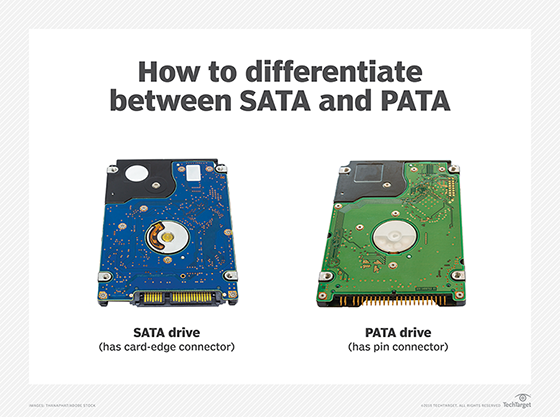Serial ATA (Serial Advanced Technology Attachment or SATA)
Serial ATA (Serial Advanced Technology Attachment or SATA) is a standard for connecting and transferring data from hard disk drives (HDDs) to computer systems. As its name implies, SATA is based on serial signaling technology, unlike Integrated Drive Electronics (IDE) hard drives that use parallel signaling.
SATA has several advantages over the Parallel ATA (PATA) hard drives developed in the 1980s. SATA cables are thinner, more flexible and less massive than the ribbon cables required for conventional PATA hard drives.
Setting SATA controller modes
Serial ATA hard drives connect to a computer's motherboard via SATA controller hardware that manages the flow of data. Putting SATA in IDE mode means the hard drive is recognized as a PATA device -- a situation that provides better compatibility with older hardware, but comes with the tradeoff of lower performance.
Setting a SATA controller to Advanced Host Controller Interface (AHCI) offers higher performance than IDE mode, and also enables features such as hot swapping on SATA drives. The redundant array of independent disk (RAID) mode supports both AHCI functions and RAID data protection features.
Technical differences between SATA and PATA
The SATA transport layer differs from PATA drives, in which data bits are delivered simultaneously
across a 40-pin-wide ribbon cable. As its name suggests, a Serial ATA drive transfers data in serial fashion. Data is moved one bit at a time between a SATA drive and its host, using a seven-pin data cable and 15-pin power cable. The SATA cable results in a higher signaling rate, which corresponds to faster throughput of data.
 SATA cables can be considerably longer than PATA ribbon cables, allowing a system designer more latitude in the physical layout of a system. Because there are fewer conductors, the risk of crosstalk and electromagnetic interference is lower. The signal voltage is much lower as well: 250 millivolts for SATA vs. 5 volts for PATA.
SATA cables can be considerably longer than PATA ribbon cables, allowing a system designer more latitude in the physical layout of a system. Because there are fewer conductors, the risk of crosstalk and electromagnetic interference is lower. The signal voltage is much lower as well: 250 millivolts for SATA vs. 5 volts for PATA.
